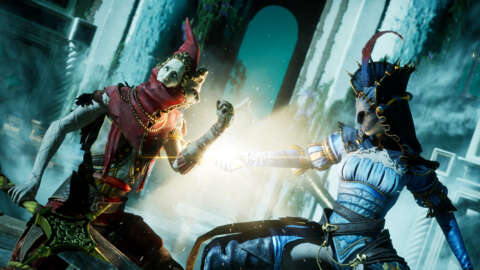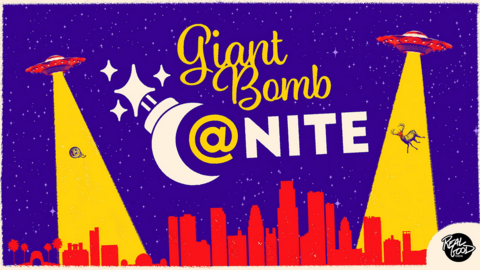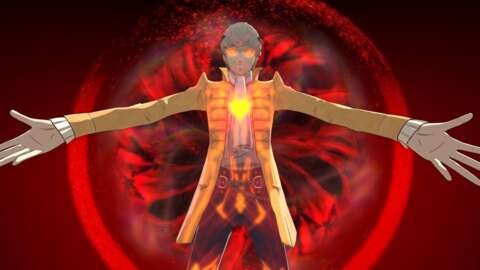There are a lot of games out there taking inspiration from and riffing on the formula that From Software popularized with its Souls games, but Enotria: The Last Song is the first one I’ve encountered that is explicitly angled at opening it up to more people.
I played Enotria at Summer Game Fest’s Play Days event, where developer Jyamma Games had a demo that featured a boss rush of three fights from the game, ramping up in difficulty. The first featured a battle with a miniboss, a jester-like guy with a spear; the second was a wispy magic-user; and the third, a giant puppet monster. All three were tough, but I took them all down well within the hour appointment time I had.
I have a lot of Souls-like experience, but part of my success in such a limited window of time was due to the coaching from Jyamma producer Eduoardo Basile on how Enotria’s signature systems work. While Enotria felt immediately familiar as a Souls-like–Jyamma says it falls somewhere between Bloodborne and Sekiro: Shadows Die Twice in terms of a focus on aggressive fighting and parrying–it’s also attempting to ease up on some of the harder-to-understand elements of From Software’s games. That’s, namely, the idea of being committed to a certain type of character or a certain type of build, which can put you at an advantage in some situations and a disadvantage in others.
In Enotria, you can hot-swap between three different loadouts at any given time, allowing you to change your approach to an enemy while you’re fighting it. Enotria is predicated on a system of masks–the whole game takes place in a supernatural stage play from which no one can escape, and defeating enemies earns you their masks to wear. Masks can provide you with benefits for a certain style of play, like enhancing your defense in melee fights or offering increased elemental damage, and you can pair them with specific weapons in your loadouts. You’ll still level up your base stats in a way that’s similar to a Souls game, but the masks and loadouts allow you to change how you’re fighting or what you’re focusing on in response to the enemy you’re facing.
This spear-wielding miniboss was first in the boss rush, sporting a long reach and a lot of agility.
In practice during the boss rush, it was a pretty effective approach. The jester miniboss was fast and agile, so a quick longsword was handy in that battle. I spent much of it avoiding strikes with quickstep dodges and parrying blows, Sekiro-style. Against the magic user, I swapped for more magic defense and to a large, heavy greatsword, which not only dealt huge damage, but also was enough to knock back and stagger my wispy opponent. That meant that regular attacks could interrupt the boss before it could pull off its annoying spells, and matched with a consumable item that restored my health whenever I did damage to my opponent, I was able to tank my way through much of the fight.
It’s a system that seems like it’ll make for a lot of gameplay versatility in Enotria. During the demo, I was told the idea here was that, while Enotria is still going to be hard–it’s still a Souls-like–the system can help players find better options for a specific battle. Approaching a boss with a loadout that takes advantage of their weaknesses, like whacking that magic-user with a heavy sword and sending him stumbling, can give you a marked advantage and, maybe, bring the difficulty of a fight down. In practice, it seems like understanding your enemy and thinking through your strategy offers a different kind of challenge than just straight input skill needed to beat bosses. Eliminating the idea of being locked into a certain type of character, or a certain type of gameplay, for all of Enotria’s 40-plus hours is the approachability the developers were hoping to bring to the subgenre.
But this is still a fast, aggressive, dodgy Souls-like. Avoiding attacks with i-frames, like in Bloodborne, is the main gist of every fight, but you can also equip special shield gems that let you parry attacks with the right timing, just like Sekiro. Enemies also have a poise meter that fills as you land attacks and successfully parry blows, and when it’s full, you’ll stagger your opponent to open them up for a big, powerful riposte attack. This is another place where swappable weapons and loadouts are key, because while you might want a fast weapon during most of a fight, switching to a big, heavy sword for a riposte increases the devastating attack’s damage significantly.
Each of the three battles had a different feel that seemed to give a decent cross-section of what Enotria’s combat and bosses will be like. As a big fan of both Bloodborne and Sekiro, I felt right at home with the systems almost instantly. For the most part, Enotria is an aggressive game where you’re rewarded for pressing the attack and parrying through your opponent’s moves. That was true even against the giant, gross puppet monster that made up the third and final fight.
This magic-using boss was tough to deal with at long range, but with a heavy sword and up close, it was easy to stagger and wallop him.
That battle had a pretty classic Bloodborne-esque feel; the monster was a huge, lumpy creature, and from its giant mouth sprang a smaller version of the actor controlling it, wielding a long staff weapon. The puppet did a lot of jumping around, landing hard and sending shockwaves rippling across the battlefield that could flatten me if I missed dodging through them. The puppet monster also inflicted a specific kind of elemental damage that, like in a From Software game, would build up a detrimental status effect. That effect was vis, one of Enotria’s four elemental effects, which is a dizziness effect that Basile likened to being drunk. Frantically dodging around and trying to get hits in simultaneously, I couldn’t tell exactly how vis messed with my character’s ability to fight, but it definitely seemed to make staying alive tougher generally.
Apart from its combat elements, Enotria’s setting, art style, and approach to its story are also enticing. The game is inspired by Italian folklore, and Jyamma describes the game as “Summer Souls” to highlight the brighter, sunnier art direction that informs its particular look. It also draws from the specific aesthetic of Italian architecture to create a world that feels a bit different from other entries into the genre, even with just a short look at the game.
Basile said Enotria is digging into the ideas that Italy is more than a series of cliche touchstones, like pizza and the Coliseum. But the story being told in Enotria, of a play that never ends and that traps people in their particular roles, is also a metaphor for cultural stagnation in the country. The game is also about the idea that for Italians, being immersed in that culture means finding it normal, and eventually, taking historic works of art and beauty for granted.
To impart those big ideas and themes, Enotria’s story will be told through the usual Souls-like means–flavor text on items and discoverable lore, as well as clues from the environment–but Basile said the team at Jyamma is also trying to make that aspect a little more approachable, as well. It sounds like the story will be delivered in a slightly more straightforward way than fans of From Software’s games might expect, more in the vein of Sekiro than Dark Souls.
Changing your mask and loadout allows you to change your playstyle on the fly.
Though I only played a few minutes of Enotria, everything I saw and heard about it left me wanting to play more. Jyamma’s approach to making a game inspired by the Souls games, while also giving it a spin specific to the developer’s culture and potentially making it more approachable, sounds like an interesting and smart way to expand on the usual Souls-like formula.
Enotria currently has an eight-hour demo available as part of Steam Next Fest. You should also check out the rest of GameSpot’s Summer Game Fest coverage.





